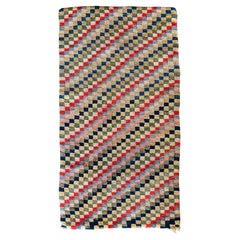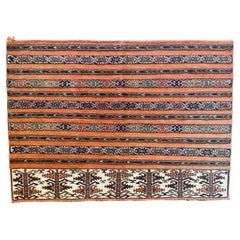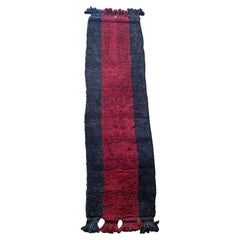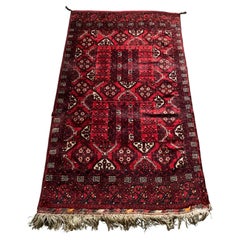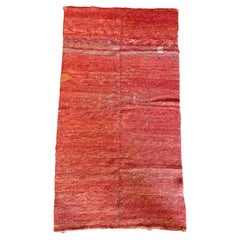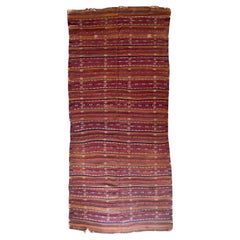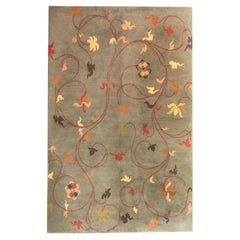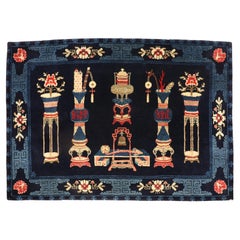PT. Tiempo Furniture And Decor Rugs and Carpets
19
to
19
19
19
19
10
5
4
Width
to
Length
to
12
12
7
7
19
8
8
7
7
Located in Jimbaran, Bali
This Checkerboard meditation rug originates from Tibet and dates to the early part of the 20th century. It is hand-knotted and crafted from naturally dyed wool from the highlands of Tibet. The rug was composed using a stunning mix of coloured squares. It is these checkerboard rugs that are highly sought after for these distinct patterns that evoke modernity. A great addition to any space, the present Tibetan Checkerboard rug...
Category
Early 20th Century Tibetan Other Chinese and East Asian Rugs
Materials
Wool
Located in Jimbaran, Bali
This Yomud tribal rug from Turkmenistan features a striking orange background as well as a mix of tribal detaili...
Category
Early 20th Century Turkmen Other Central Asian Rugs
Materials
Wool
Located in Jimbaran, Bali
This Uzbek 'Julkhyr' rug is very long, measuring 320cm in length. It was hand-knotted from 3 larger panels of ve...
Category
Mid-20th Century Uzbek Minimalist Central Asian Rugs
Materials
Wool
Located in Jimbaran, Bali
This Rug comes from the Turkmenistan Ersari Tribal group. It was originally used as the door of a tent it has a ...
Category
Mid-20th Century Turkmen Other Central Asian Rugs
Materials
Wool
Located in Jimbaran, Bali
This rug from the early part of the 20th century is made from naturally dyed wool from the highlands of Tibet. W...
Category
Early 20th Century Tibetan Other Chinese and East Asian Rugs
Materials
Wool
Located in Jimbaran, Bali
This Antique Turkish Kilim rug features a mix of orange, blue, red, and white dyed bands from wool and tribal mo...
Category
Early 20th Century Turkish Kilim Central Asian Rugs
Materials
Wool
Located in Jimbaran, Bali
This Turkish Klim rug features a stunning mix of naturally dyed wool stripes in orange, red, black & cream pigme...
Category
Early 20th Century Turkish Kilim Turkish Rugs
Materials
Wool
Located in Jimbaran, Bali
This floor mat once occupied a tribal long house of the Dayak Tribe of Borneo. It is ...
Category
Mid-20th Century Indonesian Tribal Chinese and East Asian Rugs
Materials
Rattan
Located in Jimbaran, Bali
This Antique Uzbekistan Ghudjeri Kilim's dramtic appearance is achieved using only four colours; navy blue, yell...
Category
Early 20th Century Uzbek Kilim Central Asian Rugs
Materials
Wool
Located in Jimbaran, Bali
This large antique Uzbekistan Tartari Safid Kilim was crafted from the prolific and diverse Uzbek weavers of Sar-i-Pul. It was crafted using a distinct weave double-interlock technique. Safid means white and these kilims have unusually large areas of white/ivory plain weave. The present Kilim features stunning bright orange bands and tribal patterning. Sar-i-Pul is a town set...
Category
Early 20th Century Uzbek Kilim Central Asian Rugs
Materials
Wool
Located in Jimbaran, Bali
This floor mat once occupied a tribal long house of the Dayak Tribe of Borneo. It is ...
Category
Late 20th Century Indonesian Tribal Chinese and East Asian Rugs
Materials
Rattan
Located in Jimbaran, Bali
This floor mat once occupied a tribal long house of the Dayak Tribe of Borneo. It is made from woven dyed and na...
Category
Late 20th Century Indonesian Tribal Chinese and East Asian Rugs
Materials
Rattan
Located in Jimbaran, Bali
This floor mat once occupied a tribal long house of the Dayak Tribe of Borneo. It is ...
Category
Late 20th Century Indonesian Tribal Chinese and East Asian Rugs
Materials
Rattan
Located in Jimbaran, Bali
This floor mat once occupied a tribal long house of the Dayak Tribe of Borneo. It is made from woven dyed and na...
Category
Mid-20th Century Indonesian Tribal Chinese and East Asian Rugs
Materials
Rattan
Located in Jimbaran, Bali
This Antique Uzbekistan Tartari Kilim was crafted from the prolific and diverse Uzbek weavers of Sar-i-Pul. It was crafted using a distinct weave double-interlock technique and employs a grid pattern of diamond shapes. Sar-i-Pul is a town set...
Category
Early 20th Century Uzbek Kilim Central Asian Rugs
Materials
Wool
Located in Jimbaran, Bali
This Turkmenistan Yomud tribe ceremonial horse blanket is crafted from brown felt wool and dates to the early 20...
Category
Early 20th Century Turkmen Other Central Asian Rugs
Materials
Wool
Located in Jimbaran, Bali
This Antique Uzbekistan Tartari Kilim was crafted from the prolific and diverse Uzbek weavers of Sar-i-Pul. It was crafted using a distinct weave double-interlock technique and employs a grid pattern of diamonds shapes that contain eight pointed stars. Sar-i-Pul is a town set...
Category
Early 20th Century Uzbek Kilim Central Asian Rugs
Materials
Wool
Located in Jimbaran, Bali
This floor mat once occupied a tribal long house of the Dayak Tribe of Borneo. It is made from woven dyed and na...
Category
Mid-20th Century Indonesian Tribal Chinese and East Asian Rugs
Materials
Rattan
Located in Jimbaran, Bali
This floor mat once occupied a tribal long house of the Dayak Tribe of Borneo. It is made from woven dyed and na...
Category
Late 20th Century Indonesian Tribal Chinese and East Asian Rugs
Materials
Rattan
Related Items
Located in Chicago, IL
A chic late 20th century Tibetan hand-knotted rug with a gray background and an all-over scrolling vine and styl...
Category
Late 20th Century Tibetan Modern Chinese and East Asian Rugs
Materials
Wool
Located in New York, NY
An early 20th century Chinese Peking rug
Measures: 4'5'' x 6'8''.
Category
Early 20th Century Folk Art Chinese and East Asian Rugs
Materials
Wool
Located in New York, NY
Mid 20th century Chinese Floral design rug in predominantly navy blue
Measures: 4'10'' x 7'8''.
Category
20th Century Chinese Minimalist Chinese and East Asian Rugs
Materials
Wool
Located in Chicago, IL
A beautiful early 20th century Turkish Konya Kilim rug with two large diamond medallions flanked by stylized flo...
Category
Vintage 1930s Turkish Kilim Turkish Rugs
Materials
Wool
Located in New York, NY
A vintage Tibetan throw rug handmade during the mid-20th century.
Measures: 3' 1" x 5' 8"
Chinese Rugs & Carpet:
The craft of the hand-knotted carpet in China, and the surrounding areas including Mongolia and Tibet, extends into the early centuries of the first millennium, C.E., but we really have a firm grasp only beginning in the later 16th century with large, very coarsely woven carpets, often depicting dragons, created for the Imperial Forbidden City palaces. Chinese carpets have always been commercial and there are no tribal groups responsible for any of the carpet weaving strains.
When the Ming Dynasty fell in 1644, with no Imperial patrons, production moved to the city of Ningxia in north central China where several workshops turned out more finely woven pieces for the Mandarins of the administrative Ch’ing bureaucracy and well-to-do merchants. Ningxia was the major Chinese carpet center up through most of the 19th century, with first allover and then medallion designs on cotton foundations in medium weaves. Palettes were initially limited to yellows, dark blue and cream, but later widened to include reds, browns and even green. These antiques were the first Chinese carpets to be exported to the West and they fitted in well with the craze for Chinese blue-and-white porcelain in the second half of the 19th century. Ningxia also wove shaped and rectangular small rugs for saddle underlays, chair (“throne”) seats and shaped backs, pillar carpets...
Category
Mid-20th Century Tibetan Modern Chinese and East Asian Rugs
Materials
Wool
Located in Ottawa, Ontario
Antique Chinese Baotou indigo rug, circa 1900. The central field with an intricate...
Category
Early 20th Century Chinese Chinese Export Chinese and East Asian Rugs
Materials
Wool
Located in Ferrara, IT
This Kandinsky silk rug from the late 20th century stands as a testament to abstract brilliance. Compact at 122 ...
Category
Late 20th Century Chinese Art Deco Chinese and East Asian Rugs
Materials
Silk
Located in Istanbul, TR
A happy cheerful Suzani from mid-20th century all cotton.
Category
Mid-20th Century Uzbek Suzani Central Asian Rugs
Materials
Cotton
Located in New York, NY
An antique Chinese Ningxia square throw rug handmade during the early 20th century.
Measures: 2' 3" x 2' 4"
The craft of the hand-knotted carpet in China, and the surrounding areas including Mongolia and Tibet, extends into the early centuries of the first millennium, C.E., but we really have a firm grasp only beginning in the later 16th century with large, very coarsely woven carpets, often depicting dragons, created for the Imperial Forbidden City palaces. Chinese carpets have always been commercial and there are no tribal groups responsible for any of the carpet weaving strains.
When the Ming Dynasty fell in 1644, with no Imperial patrons, production moved to the city of Ningxia in north central China where several workshops turned out more finely woven pieces for the Mandarins of the administrative Ch’ing bureaucracy and well-to-do merchants. Ningxia was the major Chinese carpet center up through most of the 19th century, with first allover and then medallion designs on cotton foundations in medium weaves. Palettes were initially limited to yellows, dark blue and cream, but later widened to include reds, browns and even green. These antiques were the first Chinese carpets to be exported to the West and they fitted in well with the craze for Chinese blue-and-white porcelain in the second half of the 19th century. Ningxia also wove shaped and rectangular small rugs for saddle underlays, chair (“throne”) seats and shaped backs, pillar carpets with dragons or monks for Buddhist monasteries, and long divided runners for monastery meditation halls. These small rugs are among the most collectible of all Chinese weavings.
Weavers from Ningxia set up workshops in the capital Peking (Beijing) in the 1860’s and began weaving Western room sizes for export, primarily to America. In blue – and – white and polychrome palettes, with round wreath medallions, precious objects, seasonal flowers, paeonies, lotuses, fretwork, clouds, butterflies and bats, all relatively spaciously drawn. The round “Shou” (Good Luck) character is also a prominent decorative motif. There are also a few Peking landscape pictorials with pagodas, houses, bridges, waterscapes and boats. Peking carpets were woven right up until WWII and production began again after the Cultural Revolution around 1970. They are moderately well-woven, on cotton foundations, exactingly executed and indisputably Chinese. Many are in the blue-and-white style. Nothing else looks like a Peking carpet and for a Chinese “look” in a room, they are absolutely indispensable. Sizes range from scatters and a few runners, through the popular 9’12’ size, to large carpets over 20’ which must have been special orders. The earliest Peking Revival carpets are pliable and fairly thin, but they became heavier and more compact in the 20th century, in competition with Art Deco carpets from Tientsin. The modern, post- 1970, pieces are in the traditional Peking style, but are a little too regular and neat. Exactitude has been favored over character, as hard to explain that as it is.
There are a number of all-silk and silk-and –metal thread pieces, many with inscriptions purporting to link them with rooms in the Imperial palaces, bringing very substantial auction prices, but none are really antique. The genre emerged after WWI and the present demand comes from mainland Chinese. The silk piles often stand in pattern relief against flat woven gold metal thread grounds. The inscriptions are apocryphal, the rugs are flashily opulent, perfect for nouveaux riches.
The Art Deco period between the two World Wars saw a distinctive carpet industry developing in Tientsin (Tianjin) in northeastern China. These are highly prized for their transitional design character, neither overtly Chinese, nor abstractly modern/contemporary. Woven exclusively for export, usually by and for American firms, such as Nichols and Elbrook, they are totally in the “Jazz Age Modern” style of the 1920’s, often without borders, with abstract or abstracted patterns, and only with, at best, a few Chinese-y pattern elements. Vases asymmetrically placed in the corners are features of some of the more Chinese-y carpets. Open fields with floral sprays and branches growing in from the edges are anther design innovation. Often, Chinese motives have been re-imagined in more sharp-edged, abstract manners. Some have no references whatsoever to natural elements. The patterns are sharp and the rugs are never subdued, soft or restrained. The rugs are heavily constructed, with crisp, unfading dyes and medium to medium coarse weaves on cotton foundations. All are extremely well-executed, with none of the vagaries, variations or twists found on even high-quality Persian rugs. The majority are in the 9’ by 12’ format and a surprising number can be found in top condition. There also was a substantial production in Peking from, especially from the Fette factory. Elliptical and round carpets, and lighter, often pastel colors, were a specialty. Nothing looks like an Art Deco Chinese and they work well with traditional Chinese furniture and the most modern decor as well. These is no substitute for a good Chinese Art Deco carpet.
Chinese carpets also include small scatters from Tibet, with high quality wool, floating dragons and allover textile patterns. The colors of vintage and modern pieces are bright, but there are antique small rugs...
Category
Early 20th Century Chinese Art Deco Chinese and East Asian Rugs
Materials
Wool
Located in Dallas, TX
76665 Vintage Tibetan Area Rug with Diamond Checkerboard Pattern, Harlequin ...
Category
Late 20th Century Tibetan Mid-Century Modern Chinese and East Asian Rugs
Materials
Wool, Silk
Located in Ottawa, Ontario
Ersari Kapunuk Turkmenistan wool rug or entrance doorway decoration, Second half of the 19th century, wool pile,...
Category
Antique Late 19th Century Turkmen Tribal Central Asian Rugs
Materials
Wool
Located in New York, NY
A vintage Tibetan throw rug handmade during the mid-20th century.
Measures: 2' 1" x 5' 4".
Category
Mid-20th Century Tibetan Art Nouveau Chinese and East Asian Rugs
Materials
Wool
